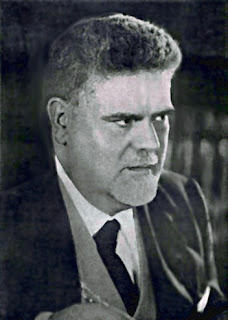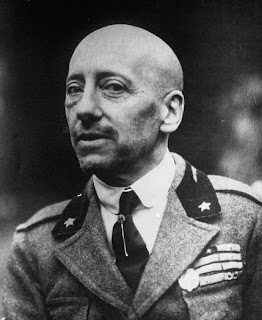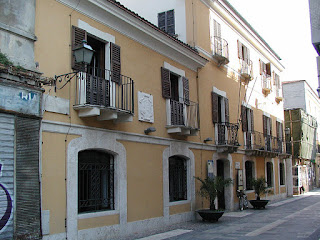Star of Parisian haute couture was born in Italy
 |
| Pierre Cardin, pictured in 2009 |
Pierre Cardin, who has been described as the last survivor
of the heyday of Parisian haute couture in the 50s and 60s, was born on this
day in 1922 in the province of Treviso, north of Venice.
There are differing versions of the story of Cardin’s
Italian origins.
One says that his parents were French but had a holiday home
in Italy and that he was born in the village of Sant’ Andrea di Barbarana, on
the Piave river, where his parents had a house.
Another says that his father was Italian, a labourer, that
he was born in another small town in the province, San Biagio di Callalta and
that he was the last of 11 children. This version suggests his father was in
his 60s when Pierre – christened Pietro – was born.
What is agreed is that the family left Italy for France in
1924, possibly because of his father’s unease at the rise of Mussolini and his
opposition to Fascism.
They settled in the industrial city of Saint-Etienne, where
Pierre began his career in the clothing industry in 1936 when he was taken on
as a tailor’s apprentice.
He moved to Vichy in 1939 and worked during the Second World
War for the Red Cross before relocating to Paris in 1945, determined to make
his name in the fashion world.
 |
| The trademark Pierre Cardin bubble dress of the 1950s |
At first, he worked with the Italian designer Elsa
Schiaparelli and designed costumes for the film director Jean Cocteau. before
joining Christian Dior. His talent shone
through from an early stage and in 1950 he started his own fashion house.
The first Pierre Cardin dresses were unveiled at a lavish
masquerade ball in 1953 – dubbed ‘the party of the century’ – in a palace on
the Grand Canal in Venice.
Cardin’s first boutique, Eve, opened in Paris in 1954, the
same year that his so-called ‘bubble dress’ – a loose-fitting dress tightened
near the waistline and brought in at the hem to create a ‘bubble’ effect –
brought him international success.
He became known for his avant-garde designs, inspired often
by things he had seen in travelling around the world. His clothes for a while showed a Japanese
influence after he had visited Tokyo in 1957 to open Japan’s first high fashion
store.
Later, after he had visited NASA headquarters in Washington,
his designs began to have a futuristic space-age look.
Cardin was one of the first designers to realise the
potential of ready-to-wear as haute couture began to decline in the 1960s. Indeed,
he was expelled from the snooty Chambre Syndicale – the guardian of fashion
standards – for launching a ready-to-wear line in the department store
Printemps, although he was quickly reinstated.
He was also a pioneer of the designer label culture,
launching a collection during the late 1960s that was the first to include the
designer’s logo stitched on each garment.
He became something of an iconic figure of the Swinging Sixties era,
designing clothes for both The Beatles – the collarless jackets were his idea –
and The Rolling Stones.
 |
| The Pierre Cardin logo is known the world over |
In 1971 he turned a former theatre in Paris into Espace
Cardin, where he would not only show his clothes but would also promote rising
artistic talents – in music and theatre – by offering them the chance to
perform on his stage.
In time, much to the disapproval of some of his
contemporaries in the Paris fashion world, the Pierre Cardin name began to
appear on all manner of products – from baseball caps to cars – as the company
sought to exploit the brand. Some
critics condemned him for ‘cheapening’ the company’s image; others applauded his
entrepreneurialism.
The company bought Maxim’s in Paris in 1981 and from it developed
a worldwide chain of exclusive restaurants and hotels.
In 2011, the business was valued at around $1 billion.
Cardin’s proud boast was that he built the business from scratch, without ever
having to borrow money.
Cardin, now in his 90s and, until recently, still designing
clothes personally in his studio, owns among other homes a castle at Lacoste, Vaucluse
once owned by the Marquis de Sade and a palazzo in Venice that he claims once
belonged to Giacomo Casanova, although history shows that its historical owner
was Giovanni Bragadin di San Cassian, Bishop of Verona and Patriarch of Venice.
 |
| The Ca' d'Oro is one of the most famous palaces on the Grand Canal in Venice |
Travel tip:
The buildings that line the Grand Canal in Venice, of which
there are about 170, were mostly built between the 13th and the 18th century, when
noble Venetian families wanted to show off their wealth in suitable palaces.
Among the most famous are the Palazzo Barbaro, Ca' Rezzonico, Ca' d'Oro,
Palazzo Dario, Ca' Foscari, Palazzo Barbarigo and the Palazzo Venier dei Leoni,
which today houses the Peggy Guggenheim Collection.







